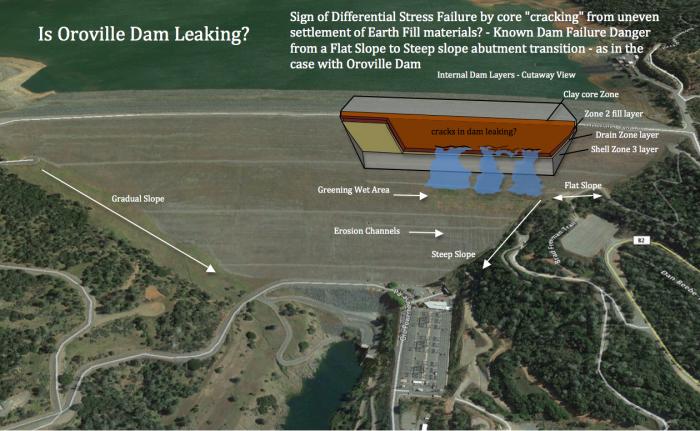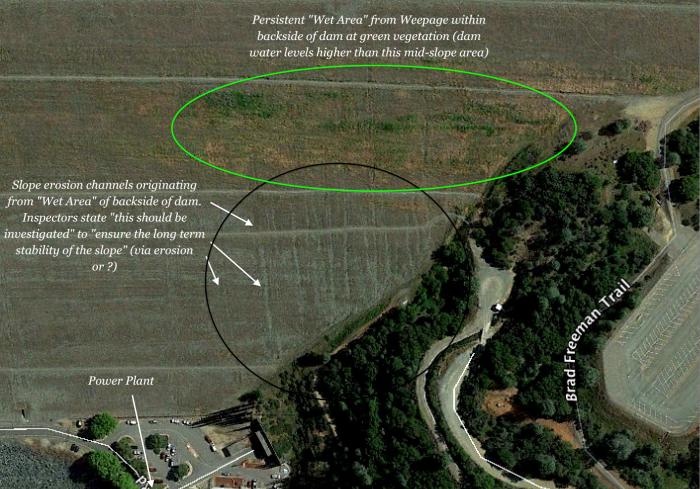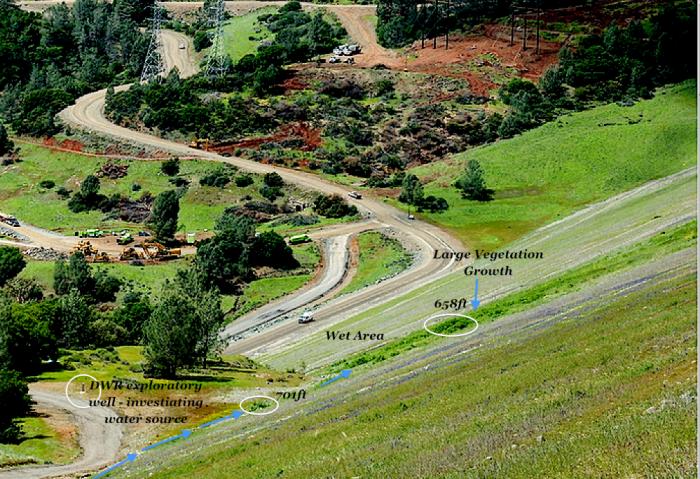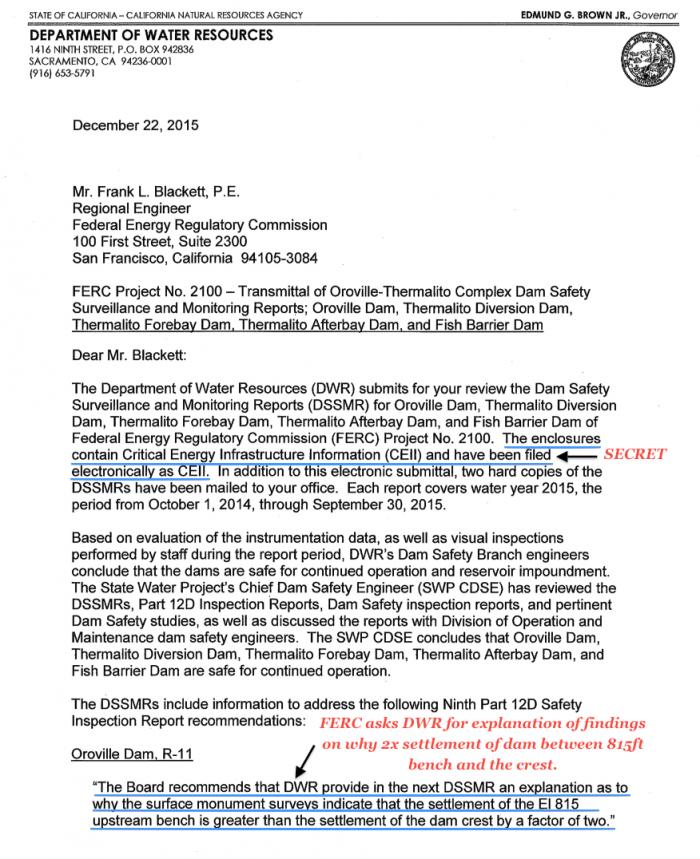We ask you, urgently: don't scroll past this
Dear readers, Catholic Online was de-platformed by Shopify for our pro-life beliefs. They shut down our Catholic Online, Catholic Online School, Prayer Candles, and Catholic Online Learning Resources essential faith tools serving over 1.4 million students and millions of families worldwide. Our founders, now in their 70's, just gave their entire life savings to protect this mission. But fewer than 2% of readers donate. If everyone gave just $5, the cost of a coffee, we could rebuild stronger and keep Catholic education free for all. Stand with us in faith. Thank you.Help Now >
Oroville Dam Breach? DWR Investigating Leaking - Hasn't Revealed this to the Public
FREE Catholic Classes
A Leak in the core of an Earthen Dam is known to trigger catastrophic failure within hours. Oroville's Earthen Dam has a persistent "leaking" of seepage water flow on the left mid-slope backside of the embankment. This persistent leaking has caused noticeable green vegetation growth in this area while creating visible "erosion" channels down the backside facing of the dam. DWR Safety Inspection reports have repeatedly noted that "this should be investigated". Yet it is still unknown to DWR as to the source of this leakage, thus creating an unknown risk to a potentially swift and catastrophic dam failure mechanism.

The green area on the face of the dam suggests water is seeping though the dam.
Highlights
Catholic Online (https://www.catholic.org)
4/25/2017 (8 years ago)
Published in Green
Keywords: Oroville Dam, Breach, Differential Settlement, Leakage, FERC, DWR
LOS ANGELES, CA (California Network) - Oroville Dam may be facing a similar breach danger as in the June 5, 1976, Idaho Teton Dam collapse - it all started by water "seepage". Any unexpected water seepage in an Earthen Dam, such as the Oroville Dam, is cause for great alarm. The catastrophe at the Teton Earthen Dam's sudden collapse started somewhat quietly in seeping clear water. First one location, then another. Soon the full crumbing earthen dam sent a cascade of water rushing through downstream communities of the Teton and Snake River floodplains. President Ford declared the collapse and subsequent flooding a major disaster just one day later [1]. Of the 23 presidentially declared disasters in Idaho, the Teton Dam's collapse remains the only man-made disaster. Dale Howard, quoted in Time's "Teton: Eyewitness to Disaster" described the scene, "When the water hit the power plant below..."it just disintegrated. The water picked up a huge oil tank like a cork and away it went. There was a beautiful grove of cottonwood trees down below, and they were snapped off like matchsticks. Later I could see the water out on the plain. It was almost like a surrealist picture; as the water hit some of the farm fields, you could see an eerie cloud of dust and mist rise up three to five miles away." [1]
Dale Howard and his wife Linda had witnessed the mighty collapse of the majestic 307ft-high 3,000 ft-long Teton Dam. Just before the collapse, one of their children recalls "This wet spot on the side of the dam started spurting a little water and I asked my mother, 'Do you think we should notify the authorities?' She said: 'I don't think it could be too serious because nobody is sticking his finger in the hole." [2].
Oroville Dam dwarfs the magnitude of the Teton Dam as Oroville is the tallest dam in the United States. Registering in at 770 ft-high, 6,920 ft-long, and 77.619 million cubic yards in volume of specially compacted "Zone Layers" of mixtures of boulders, cobbles, gravels, sands, silt, and clay [3]. Considered an engineering marvel, yet statistics worldwide reveal that 60% of all dam failures are attributed to Earthen Dams. The economic benefits, of a lower cost of building earthen dams, requires a commensurate degree of careful maintenance and monitoring. In contrast to a solid concrete dam, an earthen dam is designed using sheer weight of layered materials to hold back large bodies of water. Layers of material are compacted to careful densities with specialized construction equipment to insure the integrity of the performance to meet the stress loads of retaining a large reservoir under great water pressures.
The key to water blockage to an earthen dam is the center "core" zone. It is commonly engineered to be a high concentration of clay or clayey based material. The other vertical layer "Zones" are designed for the structural support of this critical "core". The outermost layer is the massive gravity based "shell layer" that is mostly cobbles, gravels, and boulders. The long term reliability and Safety of an Earthen dam requires monitoring the gradual slow compaction of the dam from its own weight. This is called "settlement". Oroville Dam has been engineered to slowly "settle" at a maximum value over the life of the dam. In the first 7 years of Oroville dam, the "settlement" was measured to be less than 1 foot - well within the engineering design calculations. As with other earthen dams, the slow "settlement" is a continued compaction of the materials by gravity and other hydrological effects and is normal.
DWR is trying to understand this leakage as noted in a 2015 request to FERC to relocate a monitoring drill hole to a location near the leakage area. DWR stated: "The new proposal moves the drill hole originally planned at Oroville Dam's toe to the Left Abutment (off dam) at about elevation 670 feet.", "DWR plans to install a piezometer at this location for the purpose of monitoring groundwater levels in proximity to the historic 'green spot' within the dam embankment. Data collected may be beneficial in understanding seepage within the Left Abutment."
Oroville Dam may be exhibiting a dangerous failure mode from an effect known as "Differential Settlement". This phenomenon occurs by sections of the dam "compacting" at a different rate. Thus, internal forces are applied to the center of the dam that has known to cause loss of the integrity of the core, cracking of the core, clogging of the internal drainage system, and longitudinal cracking along the interface between embankment zone fill materials [6]. Historic failures of "Differential Settlement" at dams has found a critical component that risks the danger from the dam having an abutment with a "sharp abutment" slope change [4][6]. A first sign of this alarming problem would be unexplained seepage, wet spots, or greening areas on the back side of the dam (to which Oroville Dam is exhibiting).
Oroville Dam has a classic failure architecture characteristic, of a "sharp abutment change in slope", that has led to embankment dam failures from uneven compaction. This is called "Differential Settlement Failure". A steep slope transition, from a gradual slope, in the abutment side of the dam, may lead to a greater compaction rate in the steeper section and a slower compaction rate in the gradual slope area. The internal stresses from the massive volume of Zone layer materials, in settling at different rates, is known to cause horizontal type failure cracking in the core of the dam, leading to dangerous leakage, internal erosion, and subsequent failure of the dam [4][5]. The leakage in the core disperses soil type material that defeats the vertical chimney "Drain Zone" by clogging the boulder, cobble, and gravel mix [5][6]. Thus, the soil dispersal is able to continue to form a horizontal "bench" flow that exits as a linear area of seepage. This is the exact pattern observed on the mid-slope backside embankment of Oroville dam. If an internal leakage of water from such longitudinal cracking were to escalate in the volume of flow, erosion would accelerate the budding "failure mode" to the point of no return. Earthen Dams have been repaired in fixing "differential settlement" leakage dangers by drilling into the core and injecting sealing mixture compounds of clay & Bentonite material.
Alarm? DWR discovers 2x "Differential Settlement" which is revealed in a December 22, 2015 memo on a Dam Safety Surveillance and Monitoring Reports (DSSMRs) letter to FERC [Fig 4]. The 2x "settlement" difference is noted from the crest of the dam to a reservoir embankment bench at elevation marker EL 815. If there is a discovered "Differential Settlement" that is 2x the amount from an evenly progressing compaction settlement, are there other areas of the dam that may be exhibiting further "differential settlement"? The report does not identify the extent of DWR's survey of the 100 emplaced monuments at the original construction of the dam. Is it possible that just a "sampling" of some monuments are conducted, thus missing the opportunity to detect a subtle yet critical change near the "leakage areas"?
Is a breach imminent? Only with swift attention to determining the potential of internal cracks within the core may this question be answered. To date, DWR is still investigating, but they do not know the cause. With the crisis of the Spillway failures and emergency reconstruction efforts, at which nearly $521 million dollars have been spent or allocated, there should be some serious attention given to the leakage issue on the dam. This leakage may be misleading in its clues to DWR as the "clogging" of the Drain Zone would mask a fluctuation in the normal seepage at the collection monitoring stations at the toe of the dam. Unfortunately, a major obstacle may impede resolving an answer to this question as the reservoir height would need to be dropped below 660 ft. Any "test drill" to the core would require a safe level where the internal water "phreatic" level would necessitate being lower than the drill probe insertion. Thus, Oroville Dam may be in a state where this question may not be immediately answerable or even mitigate-able due to the current crisis and the ever flowing runoff to reservoir height.
At this point, Public Awareness may be the only option. Keeping potential risk information from the residents would be a great disservice as this potential issue could escalate swiftly, with little warning for evacuation. Just as was the case of the smaller, yet mighty Teton Dam.
Note: markups in blue underline, arrows, and red text added as commentary to original document.

Fig 1. Sign of "Differential Settlement" inferring "cracks" within the core of Oroville Dam. Greening Wet Area, with erosion channels, being investigated by DWR. "Differential Settlement Failure" known to occur from Steep Slope Abutment transitions, as observable in Oroville's side abutment. Seepage is able to reach the outer shell embankment, indicating a "clogging" of the dam's internal "Drain Zone" - in addition to soil "fines" migration creating a horizontal flow bench.

Fig 2. Greening Wet Area, with erosion channels, has been noted in CA Division of Safety of Dams (DSOD) in 2014/2015/2016 Safety Inspection reports. DWR is trying to understand the cause of this leakage. The Wet Area Greening has been more noticeable in the high reservoir levels in 2017. Image courtesy of Google Earth.

Fig 3. An internal dam Seepage source of water is resulting in Large Vegetation Growth (image from April 2017). DWR has drilled an exploratory well in 2016 to try to understand this serious risk issue. Image courtesy of DWR.

Fig 4. Potential Significant sign of "Differential Settlement" - DWR to FERC communications where DWR Board recommends an explanation in a future DSSMR report back to FERC regarding an "uneven" settlement (self compaction) finding on Oroville dam. Survey data found one area settling at 2x the amount at the Crest of the Dam. Crest embankment Erosion images reveal a denser pattern of erosion channels directly above the "Wet Spot Greening area". As waterflow from the crest road finds a "low spot", this infers that there may be a link to additional "differential settlement" in the fill zones at the core of the dam. Information noted as CEII secret.
More Reading:
[1] Teton Dam disaster - 1976 Teton Dam Collapse - https://ioem.idaho.gov/Pages/History/DamCollapse.aspx
[2] Time: "Teton: Eyewitness to Disaster" http://content.time.com/time/magazine/article/0,9171,918216,00.html
[3] Oroville Dam - Tallest in the United States - https://en.wikipedia.org/wiki/Oroville_Dam
[4] Design and Construction of Embankment Dams - Differential Settlement Failure/Cracking Fig 2.4(a) sharp abutment change - http://aitech.ac.jp/~narita/tembankmentdam1.pdf
[5] Embankment Dams-Design Standards No. 13 - Longitudinal Cracking from Differential Settlement pg 5 - http://www.damsafety.org/media/Documents/DownloadableDocuments/ResourcesByTopic/DS13-11.pdf
[6] Lessons Learned from Dam Incidents and Failures - Steep rock abutments leading to "differential settlement, cracking, and failure by internal erosion - http://damfailures.org/wp-content/uploads/2015/07/Lessons-Learned-Complete-List.pdf
---
'Help Give every Student and Teacher FREE resources for a world-class Moral Catholic Education'
Copyright 2021 - Distributed by Catholic Online
Join the Movement
When you sign up below, you don't just join an email list - you're joining an entire movement for Free world class Catholic education.
- Advent / Christmas
- 7 Morning Prayers
- Mysteries of the Rosary
- Litany of the Bl. Virgin Mary
- Popular Saints
- Popular Prayers
- Female Saints
- Saint Feast Days by Month
- Stations of the Cross
- St. Francis of Assisi
- St. Michael the Archangel
- The Apostles' Creed
- Unfailing Prayer to St. Anthony
- Pray the Rosary
![]()
Copyright 2025 Catholic Online. All materials contained on this site, whether written, audible or visual are the exclusive property of Catholic Online and are protected under U.S. and International copyright laws, © Copyright 2025 Catholic Online. Any unauthorized use, without prior written consent of Catholic Online is strictly forbidden and prohibited.
Catholic Online is a Project of Your Catholic Voice Foundation, a Not-for-Profit Corporation. Your Catholic Voice Foundation has been granted a recognition of tax exemption under Section 501(c)(3) of the Internal Revenue Code. Federal Tax Identification Number: 81-0596847. Your gift is tax-deductible as allowed by law.










